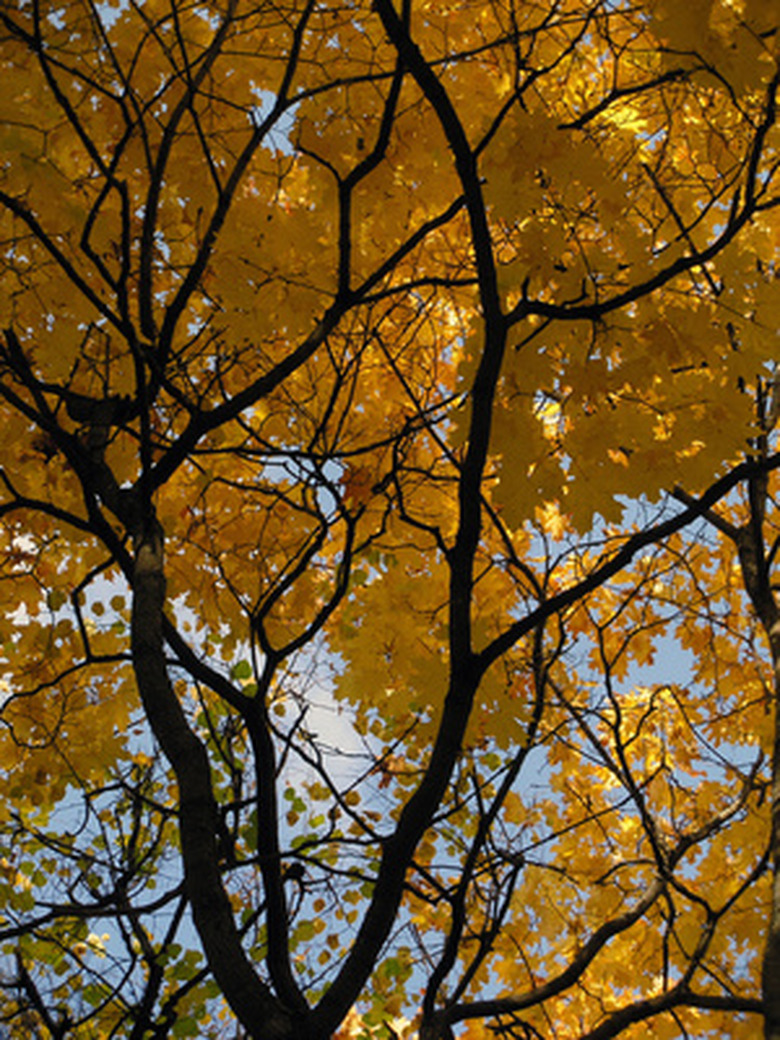Maple Trees In Washington
Maples, plants in the genus Acer, are among the loveliest of trees, and Washington has three outstanding species: big-leaf maple, vine maple and Douglas maple are all valued ornamentals, but each has a situation in which it shines. For a large shade tree, choose the big-leaf maple. For a delicate tree in part-shade, try vine maple. For a drought-tolerant small tree, plant the Douglas maple.
Big Leaf Maple
This tree, botanically known as Acer macrophyllum, is prized as an ornamental more in other areas of the world than in its native Northwest, perhaps because it is so common there. The dinner-plate-sized leaves, the massive, often moss-covered trunk and the spreading form all make it a good choice as a specimen tree where it has room to be admired, but it's not for a small garden.
Easy to grow from seed, adaptable to most areas in western Washington, the big-leaf maple needs little water once established, but will grow in moist soil, close to the edge of a pond or marsh. The area beneath the tree, however, is difficult to garden in. Choose native shrubs such as salal and evergreen huckleberry as companions.
- Maples, plants in the genus Acer, are among the loveliest of trees, and Washington has three outstanding species: big-leaf maple, vine maple and Douglas maple are all valued ornamentals, but each has a situation in which it shines.
- Easy to grow from seed, adaptable to most areas in western Washington, the big-leaf maple needs little water once established, but will grow in moist soil, close to the edge of a pond or marsh.
Vine Maple
Many people are familiar with the vine maple, Acer circinatum, as the spindly, narrow-stemmed shrub with small, roundish toothed leaves found along rivers. In fall, it's often seen as a small bush with red or orange color along mountain highways. In gardens, its form is rather different.
With plenty of water and shade, it will flourish into a nicely shaped small tree, attractively irregular, but can get up to 30 feet high and nearly as wide. When planted in groups, it is especially lovely.
In sun, it is more dense and bushy, often needing thinning to show off its truck, but it does well with regular lawn-type watering.
It can be grown from seed or you can buy nursery-grown specimens if you haven't the patience to wait for seedlings. Side branches trailing on the ground often form roots and can be removed and planted.
- Many people are familiar with the vine maple, Acer circinatum, as the spindly, narrow-stemmed shrub with small, roundish toothed leaves found along rivers.
- In sun, it is more dense and bushy, often needing thinning to show off its truck, but it does well with regular lawn-type watering.
Douglas Maple
This small tree, Acer glabrum var. douglasii, is one variety of the Rocky Mountain maple found over much of the western U.S. It is found in both lowland and mountain areas, in moist soils and in quite dry areas. Its leaves are similar to the vine maple, but slightly more pointed.
In cold winter, eastern Washington areas, this is the maple to plant, though it does quite well west of the mountains, especially in the drier areas such as the San Juan Island or in sunny, gravelly sites.
Douglas maple is not as graceful as the vine maple and tends to form multi-trunked bushes, if allowed. It does, however, have nice fall color, red, orange or soft yellow.
- This small tree, Acer glabrum var.
- In cold winter, eastern Washington areas, this is the maple to plant, though it does quite well west of the mountains, especially in the drier areas such as the San Juan Island or in sunny, gravelly sites.
It can also be propagated from seeds, which germinate prolifically.
References
- Gardening With Native Plants of the Pacific Northwest"; Arthur R. Kruckeberg; 1997
